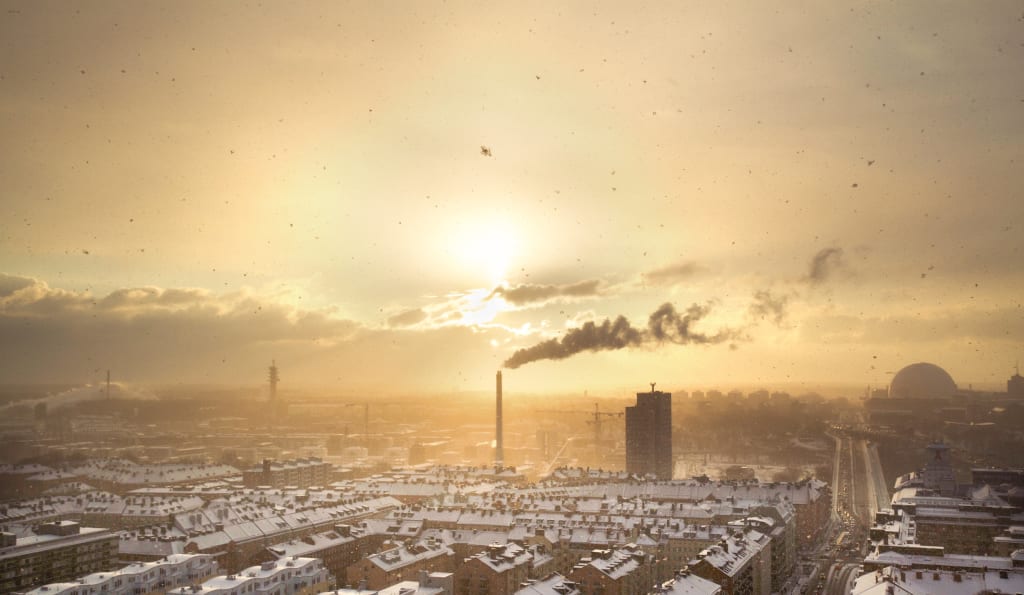A Catalytic Life
A toxic graveyard or an idyllic future - which will we choose?

I will awake as the sun rises just high enough to shine through my bedroom window and warm my face. The timer I have set to match the sunrise and automatically update with the changing seconds of every day will have raised my blinds automatically. I will head straight to the shower that has also been turned on automatically and is at the perfect temperature for me. My coffee will be waiting for me, and my juicer has already squeezed the nutrients from my fruits and vegetables. All I need to do is dress myself, sit down at the table, and choose what to read while I start my day.
I walk outside and although I don’t see it or feel it or even sense it, my clothing acts as a catalyst to break down whatever pollutants our modern society has let loose into the atmosphere. As I walk down the street towards school or a café or a job of some sort, the sidewalk is hard at work breaking down toxins that might otherwise affect my health and lower my life expectancy. The buildings are now coated with the same material as the sidewalks, and nearly every part of our infrastructure works to clean the air and make life closer to the idyllic future that we sometimes see in utopian sci-fi societies.

This is one of our possible futures, although the possibility of this particular future is lowered and pushed further and further from us with each passing month and year. Our knowledge and our technology are prepared to start production on this future right now, but the age-old demons that haunt humans every step of the way are still at work attempting to destroy us: fear and greed.
Our demons are driving us to create and exacerbate quite the opposite of the lovely dream painted above. It is estimated that approximately 12.6 million people die each year due to the fact that they live in toxic environments (WHO). As children, we learn about the wonders of the ancient world and wonder at the ingenuity of our species: The Pyramid of Giza, the Great Wall of China, the Hanging Gardens of Babylon, the Statue of Zeus at Olympia, the Temple of Artemis at Ephesus, the Mausoleum at Halicarnassus, the Colossus at Rhodes, the Lighthouse of Alexandria, the Hagia Sophia, the Taj Mahal, and so on. Those with an eye for contemporary wonders glory in the Empire State Building, the Burj Khalifa, or even more recently innovative statues like “Man and Woman” located in the Eurasian nation of Georgia.
All of these creations are glorious and speak to that side of humanity that strives to reach for the stars and lift us all up in unity. However, currently our largest, most numerous, and most often-imitated monument is the creation of environments that poison us. We use toxic chemicals to create our clothing; we allow lead-based pipes and paint to linger in our homes; and despite decades of research and proof, we still do next-to-nothing to stop our factories from polluting the air we breathe.
Our clothing is treated with a variety of chemicals in order to color, process, or finish the material. Chromium 6 is used to create dyes, however it is also carcinogenic. We use phthalates in our creation of plastic materials in which we store our food and many other uses. Phthalates are also known to alter hormone levels and cause birth defects. And when you research phthalates further and realize that we consume a number of plastic-related products, this becomes truly terrifying. Alkylphenol is used in our detergents, fragrances, and for making products fire-resistant. Although fire-resistance is a worthy goal, alkylphenols can act as xenoestrogrens, which mimic estrogen and cause a number of reproductive problems including precocious puberty. Our pesticides, herbicides, and disinfectants typically contain chlorinated phenol; when we spray these products over our food and counters, we are also making it easier to consume yet another carcinogen, and this one causes damage to the liver, kidneys, and nervous system. Of course we want our clothing to come in a variety of vibrant colors, and for this we often use azo dyes, which are carcinogenic and mutagenic.
We blanket ourselves in multiple layers of toxically treated fabrics. The straightforward solution is to simply stop purchasing products that are fire-resistant or water-resistant, as these products are most likely to contain at least a few toxic chemicals. These chemicals are killing us by contact and by us ingesting them directly and after they seep into our food and water. The only real solution is avoidance. Avoid the companies that use these chemicals, and push for legislation to prohibit their use.
However, we can take this negative idea of injecting toxic chemicals into our clothing and detergents, and use the idea for something positive. In 2010, Professor Helen Storey MBE, an artist and designer, teamed up with the chemist Professor Tony Ryan OBE to launch Catalytic Clothing. The idea behind Catalytic Clothing was to create an innovative method for combatting pollution. They came up with something quite simple and sustainable: a detergent that would make use of nanotechnology to turn our clothing into pollution fighting catalysts. Specifically, the process would create photocatalysts to break down air-born pollutants and transform them into non-harmful chemicals that are then washed away during the next laundry day.
Currently our clothing poisons us, and there is no way around it so long as these chemicals are used to create it. If we alter our clothing and turn it into pollution fighting photocatalysts, this will not increase our risk of exposure to pollution. The photocatalysts do not attract pollution; they simply destroy the pollutants we would have come into contact with either way.
Catalytic Clothing is still in the testing stage, and you can visit their website for updates.
In Canada and a few (too few) states in the US, there is a discussion on whether or not to introduce a carbon tax in order to have users of carbon fuels pay for the right to damage the environment. Although a tax could be used to inject funds into much needed solutions to the damage, we should scrutinize carefully how corporations are induced to pay fines for dumping toxic waste into rivers or disposing of it in other illegal ways. Oftentimes, the fines are not large enough to act as a deterrent since they are typically less than what it would cost to dispose of things properly in the first place. In addition, paying for the right to damage the environment is simply not a logical or feasible solution since in the end we will still be living on a poisonous planet. Stopping corporations from polluting the environment is a long and maddening quest to embark upon, mostly due to the fact that armies of lawyers and lobbyists are employed to stop any progress from being enacted. While we wait for legislation to fix the problem on one end of the pool, we will be drowning in toxic waste on the other end. However, we can do something about that other end of the pool, although creative solutions are needed.
One thing most politicians in the US do agree on is that our infrastructure is in desperate need of repair. Our bridges and roads do not look like those of one of the most technologically and economically advanced nations in the 21st century; they look more like the bridges and roads one would find in Berlin in 1945. It is an embarrassment for the American people, however it is also a tremendous opportunity.
Titanium dioxide is a substance that can be added to cement, paint, and other building materials, and when we replace our sidewalks and roads, instead of adding to the problem of our toxic environments, we would actually be fighting pollution. Titanium dioxide is another photocatalyst that could be easily used to help breakdown the pollutants our factories spew forth and buy the entire planet some more time. Add to this environmental aspect the fact that it is also very inexpensive and readily available, it becomes monumentally ignorant not to add it to every new building project and repair to our decaying infrastructure.
Chemistry is what has exposed these problems, and chemistry can be employed to rectify these problems.
The automatic blinds already exist. An automatic shower manager is on its way. Automatic coffee makers have been around for years, and an automatic juicer? Why not? Transforming our clothing and sidewalks and roads and buildings into photocatalytic pollution fighters requires the smallest of adjustments to some of our products, and it would be criminal to not pursue such a course.
About the Creator
DS Peters
Writer of all types of fiction, poetry, and odd bits of non-fiction. Traveler, scuba diver, teacher, and observer of human behavior in Saudi Arabia. Buy "Rejuvenation", my new dystopian novel, at: https://tinyurl.com/yyevad5n
Enjoyed the story? Support the Creator.
Subscribe for free to receive all their stories in your feed. You could also pledge your support or give them a one-off tip, letting them know you appreciate their work.






Comments
There are no comments for this story
Be the first to respond and start the conversation.